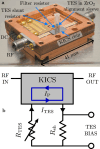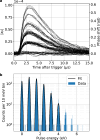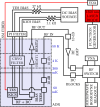Kinetic inductance current sensor for visible to near-infrared wavelength transition-edge sensor readout
- PMID: 39505997
- PMCID: PMC11541868
- DOI: 10.1038/s44172-024-00308-y
Kinetic inductance current sensor for visible to near-infrared wavelength transition-edge sensor readout
Abstract
Single-photon detectors based on the superconducting transition-edge sensor are used in a number of visible to near-infrared applications, particularly for photon-number-resolving measurements in quantum information science. To be practical for large-scale spectroscopic imaging or photonic quantum computing applications, the size of visible to near-infrared transition-edge sensor arrays and their associated readouts must be increased from a few pixels to many thousands. In this manuscript, we introduce the kinetic inductance current sensor, a scalable readout technology that exploits the nonlinear kinetic inductance in a superconducting resonator to make sensitive current measurements. Kinetic inductance current sensors can replace superconducting quantum interference devices for many applications because of their ability to measure fast, high slew-rate signals, their compatibility with standard microwave frequency-division multiplexing techniques, and their relatively simple fabrication. Here, we demonstrate the readout of a visible to near-infrared transition-edge sensor using a kinetic inductance current sensor with 3.7 MHz of bandwidth. We measure a readout noise of , considerably below the detector noise at frequencies of interest, and an energy resolution of (0.137 ± 0.001) eV at 0.8 eV, comparable to resolutions observed with non-multiplexed superconducting quantum interference device readouts.
© 2024. The Author(s).
Conflict of interest statement
The authors declare no competing interests.
Figures








References
-
- Andrews, D. H., Brucksch, W. F., Ziegler, W. T. & Blanchard, E. R. Attenuated superconductors I. For measuring infra-red radiation. Rev. Sci. Instrum.13, 281–292 (1942).
-
- Irwin, K. D. & Hilton, G. C. in Transition-Edge Sensors,Cryogenic Particle Detection, of Topics in Applied Physics (ed. Enss, C.) Vol. 99 (Springer, 2005).
-
- Richards, P. L. Bolometers for infrared and millimeter waves. J. Appl. Phys.76, 1–24 (1994).
-
- Gildemeister, J. M., Lee, A. T. & Richards, P. L. A fully lithographed voltage-biased superconducting spiderweb bolometer. Appl. Phys. Lett.74, 868–870 (1999).
-
- Irwin, K. D., Hilton, G. C., Wollman, D. A. & Martinis, J. M. X-ray detection using a superconducting transition-edge sensor microcalorimeter with electrothermal feedback. Appl. Phys. Lett.69, 1945–1947 (1996).
Grants and funding
LinkOut - more resources
Full Text Sources
